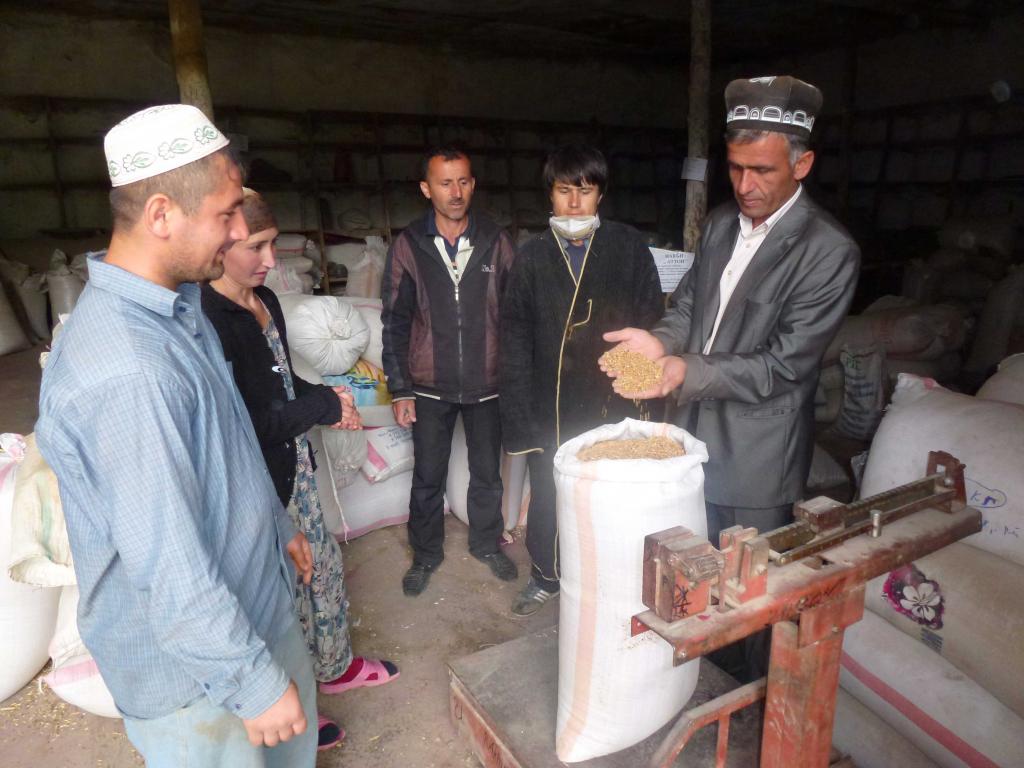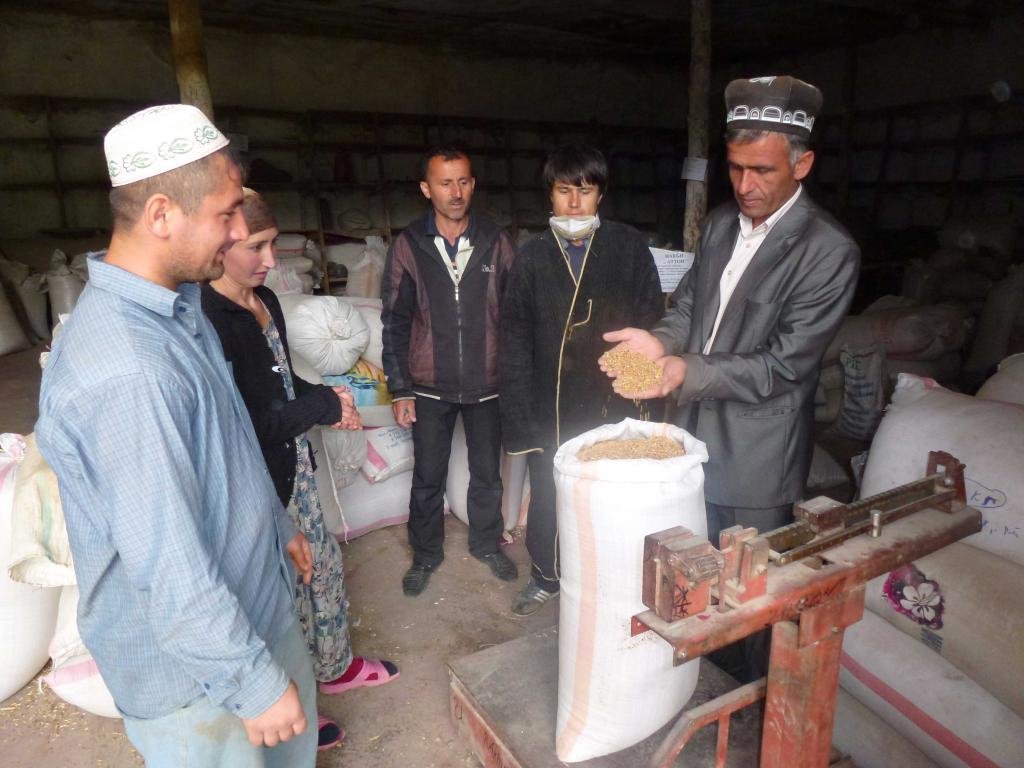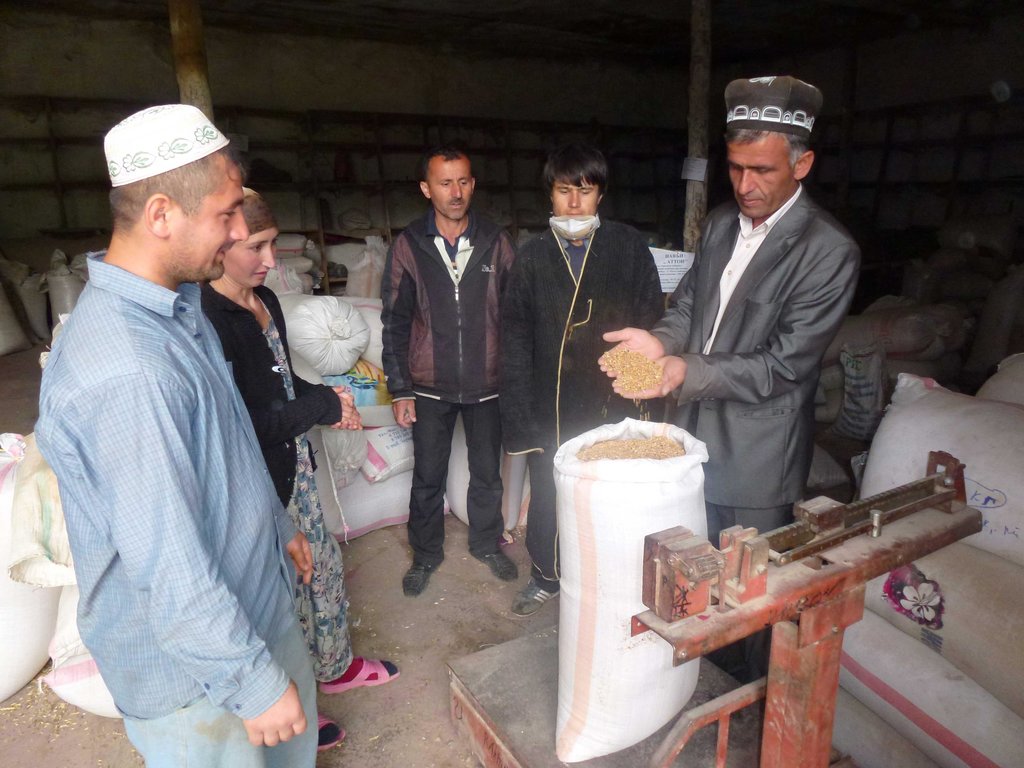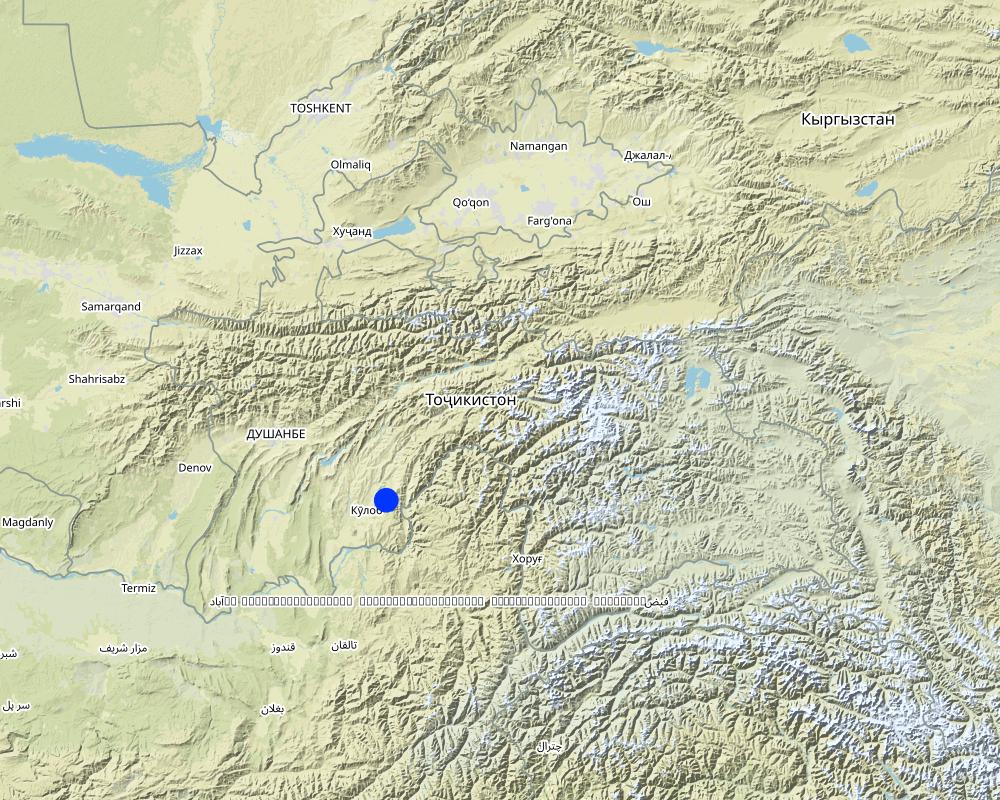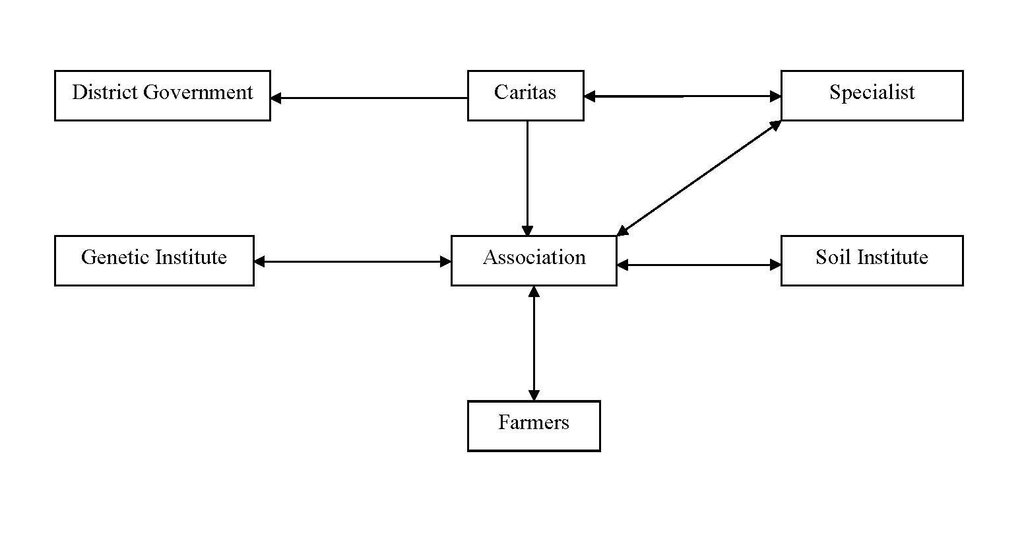District Wheat Seed Association [ຕາຈິກິສະຕານ]
- ການສ້າງ:
- ປັບປູງ:
- ຜູ້ສັງລວມຂໍ້ມູນ: Sa'dy Odinashoev
- ບັນນາທິການ: –
- ຜູ້ທົບທວນຄືນ: David Streiff, Alexandra Gavilano, Joana Eichenberger
Асотсиатсияи тухмипарвари гандум дар сатхи нохия
approaches_2440 - ຕາຈິກິສະຕານ
ເບິ່ງພາກສ່ວນ
ຂະຫຍາຍທັງໝົດ ຍຸບທັງໝົດ1. ຂໍ້ມູນທົ່ວໄປ
1.2 ລາຍລະອຽດ ການຕິດຕໍ່ ຂອງບຸກຄົນທີ່ຊັບພະຍາກອນ ແລະ ສະຖາບັນ ການມີສ່ວນຮ່ວມ ໃນການປະເມີນຜົນ ແລະ ເອກະສານ ຂອງວິທີທາງ
ຜູ້ຊ່ຽວຊານ ດ້ານການຄຸ້ມຄອງ ທີ່ດິນແບບຍືນຍົງ:
ຊື່ຂອງໂຄງການ ທີ່ອໍານວຍຄວາມສະດວກ ໃນການສ້າງເອກກະສານ ຫຼື ປະເມີນດ້ານແນວທາງ (ຖ້າກ່ຽວຂ້ອງ)
Pilot Program for Climate Resilience, Tajikistan (WB / PPCR)ຊື່ຂອງ ສະຖາບັນການຈັດຕັ້ງ ທີ່ອໍານວຍຄວາມສະດວກ ໃນການສ້າງເອກກະສານ ຫຼື ປະເມີນແນວທາງ (ຖ້າກ່ຽວຂ້ອງ)
NCCR North-South (NCCR North-South) - ກີກັດຕັນ1.3 ເງື່ອນໄຂ ຂອງການນໍາໃຊ້ເອກກະສານຂໍ້ມູນ ຂອງ WOCAT
ເມື່ອໃດທີ່ໄດ້ສັງລວມຂໍ້ມູນ (ຢູ່ພາກສະໜາມ)?
10/03/2010
ຜູ້ສັງລວມ ແລະ ບັນດາຜູ້ຕອບແບບສອບຖາມ ຍອມຮັບໃນເງື່ອນໄຂ ການນໍາໃຊ້ຂໍ້ມູນເອກະສານ ທີ່ສ້າງຂື້ນ ໂດຍຜ່ານ ອົງການ WOCAT:
ແມ່ນ
2. ພັນລະນາ ແນວທາງການຄຸ້ມຄອງນໍາໃຊ້ດິນແບບຍືນຍົງ
2.1 ການອະທິບາຍ ໂດຍຫຍໍ້ ຂອງວິທີທາງ
The Seed Association was established with the aims of improving the living conditions, food security, land management and crop rotation systems in irrigated and rain fed areas. The Seed association in Muminabad is registered at a district level and coordinates the activities of the farmers and members.
2.2 ການອະທິບາຍ ລາຍລະອຽດ ຂອງວິທີທາງ
ການອະທິບາຍ ລາຍລະອຽດ ຂອງວິທີທາງ:
Aims / objectives: The aim of this approach is to provide a long term wheat seed bank to improve food security in the district of Muminabad, Tajikistan. Previously, there was a lack of readily available good quality seed that was appropriate to the soil, and climatic conditions of the area. The aim of the approach was to provide cost effective, appropriate wheat seeds to farmers with more than 5h.a. of land. The farmers receive training and onsite support during the cultivation period, and in return have to adopt a crop rotation system, and give back to the association 150% of the originally received seed stock. The association continues to cultivate, and test, high quality seeds on its own land for distribution, and for selling at the local market to generate revenue to cover its operational costs.
Methods: The Association's members have to stick to a set of pre-determined conditions in order to join, and so operations can be controlled. The members must implement changes in agricultural practices, to support the work of the association. In return the members receive high quality tested seed, training and a support network.
Stages of implementation: The initial set up of the wheat association was provided by INGO (Caritas Switzerland) who provided the initial funding and support, which was supplemented by the provision of a 150h.a of arable land by the government. The initial five members of the association were provided with training in organisational set up and business development, they employed the services of an agronomist to help acquire appropriate seeds and develop a seed bank on the arable land. The association registered as a legal entity, and the INGO provided co-funding for agricultural machinery and fuel, for the development of the seed bank. Once sufficient seed was accumulated to start distribution, farmers with just 5h.a. of irrigated land were invited to become members. The members had to provide land user documentation, accept to undertake crop rotation techniques, and follow the advice of the association’s agronomist in return for free seed.
Role of stakeholders: The role of the stakeholders is to follow all the rules of the association, which include the strict compliance with a set of pre-determined conditions laid out in a contract. There is a strong element of trust among the association and its members. Such an environment helps make the wheat growing in the district successful.
Other important information: The approach is highly reliant on effective communication between the association's specialists and it's members. The members communicate with specialists regarding technological issues, land management and other issues that are not clear in the process. In return, the association through the agronomist provides timely support, advice and materials (e.g. fertiliser, pesticides). If the members are very successful and produce high quality seed from the association’s batch, the association will buy all the seed the farmer cultivated, and use it to improve the seed stock of the district.
2.3 ຮູບພາບຂອງແນວທາງ
2.5 ປະເທດ / ເຂດ / ສະຖານທີ່ບ່ອນທີ່ແນວທາງໄດ້ຖືກນໍາໃຊ້
ປະເທດ:
ຕາຈິກິສະຕານ
ພາກພື້ນ / ລັດ / ແຂວງ:
Tajikistan, Khatlon
ຂໍ້ມູນເພີ່ມເຕີມຂອງສະຖານທີ່:
Muminabad
Map
×2.6 ວັນທີເລີ່ມຕົ້ນ ແລະ ສິ້ນສຸດ ການຈັດຕັ້ງປະຕີບັດ ວິທີທາງ
ສະແດງປີຂອງການເລີ່ມຕົ້ນ:
2006
ປີທີ່ສີ້ນສູດ (ຖ້າຢຸດບໍ່ໄດ້ນໍາໃຊ້ ວິທີທາງ):
2010
2.7 ປະເພດຂອງແນວທາງ
- ພາຍໃຕ້ໂຄງການ / ແຜນງານ
2.8 ເປົ້າໝາຍ / ຈຸດປະສົງຫຼັກ ຂອງການຈັດຕັ້ງປະຕິບັດ ວິທີທາງ
The Approach focused mainly on other activities than SLM (Improvement in yields and quaility of the wheat crops.)
To establish an organisation that would be able to provide easily accessible, reasonably priced, high quality wheat seed to the local land users. To ensure that the organisation was sustainable through the testing of the seed, creating a local seed bank, and by providing practical training to farmers on wheat cultivation and harvesting. The long term goal was to continue to build the capacity of the seed bank so that the association could increase the number of beneficaries/members.
The SLM Approach addressed the following problems: The main issues that were addressed included a lack of availability of wheat seeds and the fact that those available were of poor quality so produced low yields. The final wheat harvest was of such a low standard that majority of the harvest ended up as cattle feed. Some of the wheat seeds purchased outside the district were not appropriate for the climatic soil conditions of this district. The land users also had a fundamental lack of knowledge about wheat production, which was compounded by labour migration of many of the skilled male population to Russia.
2.9 ເງື່ອນໄຂອໍານວຍ ຫຼື ຂັດຂວາງການປະຕິບັດຂອງເຕັກໂນໂລຢີ / ເຕັກໂນໂລຢີການນໍາໃຊ້ຕາມແນວທາງ
ມີຄວາມສາມາດ / ເຂັ້າເຖິງຊັບພະຍາກອນດ້ານການເງິນ ແລະ ການບໍລິການ
- ເຊື່ອງຊ້ອນ
The farmers sometimes do not return seeds to the association as per their contract.
Treatment through the SLM Approach: A contract is signed between the Wheat Association and the land user. The association writes a letter to the farmer stating that if the farmer does not bring back the seeds, the association will write a letter to the district court.
ການກໍ່ຕັ້ງສະຖາບັນ
- ເຊື່ອງຊ້ອນ
The staff of the Wheat Association lacked experience in organisational set up and operation.
Treatment through the SLM Approach: A series of business training sessions were provided for the staff, and an agronomist monitored the seed production.
ກ່ຽວກັບກົດໝາຍ (ສິດນໍາໃຊ້ດິນ, ສິດນໍາໃຊ້ນໍ້າ)
- ອໍານວຍ
The existing land ownership, land use rights / water rights moderately helped the approach implementation: Land owners with 5h.a. of agricultural land have certificates of use. However, if the minimum area was reduced from 5h.a. it could present issues where no formal documentation is currently in place.
- ເຊື່ອງຊ້ອນ
The wheat association has to ensure that the land user has a land user certificate, or a contract to rent the land.
Treatment through the SLM Approach: The relevant documentation is checked before seeds are issued.
ຄວາມຮູ້ກ່ຽວກັບການຄຸ້ມຄອງ ທີ່ດິນແບບຍືນຍົງ, ການເຂົ້າເຖິງການສະໜັບສະໜູນ ທາງດ້ານວິຊາການ
- ເຊື່ອງຊ້ອນ
The association was provided with 150 h.a to produce seed, however it needed materials, labour and equipment to cultivate wheat on this land.
Treatment through the SLM Approach: Initial support was provided through funding provided by an INGO.
ອື່ນໆ
- ເຊື່ອງຊ້ອນ
The Wheat Association needed 150 h.a. to act as a seed bank.
Treatment through the SLM Approach: This land was provided by the local government. However, this could also be overcome by renting the land required.
3. ການມີສ່ວນຮ່ວມ ແລະ ບົດບາດຂອງພາກສ່ວນທີ່ກ່ຽວຂ້ອງທີ່ໄດ້ມີສ່ວນຮ່ວມ
3.1 ຜູ້ມີສ່ວນຮ່ວມ ໃນວິທີທາງ ແລະ ພາລະບົດບາດ ຂອງເຂົາເຈົ້າ
- ຜູ້ນໍາໃຊ້ດິນໃນທ້ອງຖິ່ນ / ຊຸມຊົນທ້ອງຖິ່ນ
Land users with more than 5h.a. were the main target group.
There are currently contracts in place with around 90 men and 9 women. This is due to the stipulation that the land user is required to have 5h.a of irrigated land before they will be provided with seed by the association.
A land user proposed the idea to the NGO, who developed the idea in collaboration with local agronomists.
Supported in establishing and publicising the operations of the association.
- ຜູ້ຊ່ຽວຊານ ການນຄຸ້ມຄອງ ທີ່ດິນແບບຍືນຍົງ / ທີ່ປຶກສາດ້ານກະສິກໍາ
- ອົງການຈັດຕັ້ງ ທີ່ບໍ່ຂື້ນກັບລັດຖະບານ
International non-government
Financed the initial set up costs.
- ອໍານາດ ການປົກຄອງທ້ອງຖິ່ນ
Supported by providing buildings, land and documentation.
3.2 ການມີສ່ວນຮ່ວມຂອງຜູ້ນໍາໃຊ້ທີ່ດິນໃນທ້ອງຖິ່ນ / ຊຸມຊົນທ້ອງຖິ່ນໃນໄລຍະທີ່ແຕກຕ່າງກັນຂອງແນວທາງ
| ການລວບລວມ ເອົາຜູ້ນໍາໃຊ້ດິນ ໃນທ້ອງຖິ່ນ / ຊຸມຊົນທ້ອງຖິ່ນ | ໃຫ້ລະບຸ ຜູ້ໃດທີ່ມີສ່ວນຮ່ວມ ໃນແຕ່ລະກິດຈະກໍາ? | |
|---|---|---|
| ການເລີ່ມຕົ້ນ / ແຮງຈູງໃຈ | ການບໍ່ປະຕິບັດ | Land users developed the orginal concept and ideas. |
| ການວາງແຜນ | ການຊ່ວຍເຫຼືອຈາກພາຍນອກ | Local agronomists and local government were involved in the planning stage. |
| ການປະຕິບັດ | ການນໍາໃໍຊ້ເອງ | The members of the association are responsible for the implementation of the project. |
| ຕິດຕາມກວດກາ / ການປະເມີນຜົນ | ການນໍາໃໍຊ້ເອງ | The agronomist continues to check cultivated plots. |
| Research | ການຊ່ວຍເຫຼືອຈາກພາຍນອກ | Research was undertaken on the suitability of different seed types for the agro-climatic zone. |
3.3 ແຜນວາດ (ຖ້າມີ)
ການອະທິບາຍ:
Organisational Chart showing the establishment set up of the Wheat Association
ຜູ້ຂຽນ:
Sady Odinashoev (Muminabad, Tajikistan)
3.4 ການຕັດສິນໃຈກ່ຽວກັບການຄັດເລືອກເຕັກໂນໂລຢີຂອງການຄຸ້ມຄອງທີ່ດິນແບບຍືນຍົງ / ເຕັກໂນໂລຢີ
ລະບຸ ຄົນທີ່ຕັດສິນໃຈ ກ່ຽວກັບການຄັດເລືອກຂອງ ເຕັກໂນໂລຢີ / ເຕັກໂນໂລຢີ ຈະໄດ້ຮັບການປະຕິບັດ:
- ຜູ້ນໍາໃຊ້ທີ່ດິນຫຼັກ, ການສະໜັບສະໜູນ ໂດຍຜູ້ຊ່ຽວຊານ ການນໍາໃຊ້ທີ່ດິນແບບຍືນຍົງ
ອະທິບາຍ:
The land users are provided with the seed to improve the yield and quality of the crops, under the supervision of the agronomist from the association.
Decisions on the method of implementing the SLM Technology were made by mainly by land users supported by SLM specialists. The agronomist provides ongoing support to the land user during the cultivation period.
4. ການສະໜັບສະໜູນທາງດ້ານວິຊາການ, ການສ້າງຄວາມສາມາດ, ແລະ ການຈັດການຄວາມຮູ້.
4.1 ການສ້າງຄວາມສາມາດ / ການຝຶກອົບຮົມ
ຜູ້ນໍາໃຊ້ທີ່ດິນ ຫຼື ພາກສ່ວນກ່ຽວຂ້ອງອື່ນໆ ໄດ້ຮັບການຝຶກອົບຮົມບໍ່?
ແມ່ນ
ໃຫ້ລະບຸ ຜູ້ໃດທີ່ໄດ້ຮັບການຝຶກອົບຮົມ:
- ຜູ້ນໍາໃຊ້ດິນ
- ພະນັກງານພາກສະໜາມ / ທີ່ປຶກສາ
ຮູບແບບຂອງການຝຶກອົບຮົມ:
- ການເຮັດຕົວຈິງ
- ຕົວຕໍ່ຕົວ
- ເນື້ອທີ່ສວນທົດລອງ
- ຫຼັກສູດ
ໃນຫົວຂໍ້:
Workshops were conducted on wheat cultivation, crop rotation techniques, and seed types to the land users.
4.2 ການບໍລິການໃຫ້ຄໍາປຶກສາ
ເຮັດຜູ້ໃຊ້ທີ່ດິນມີການເຂົ້າເຖິງການບໍລິການໃຫ້ຄໍາປຶກສາ?
ບໍ່ແມ່ນ
4.3 ສະຖາບັນການສ້າງຄວາມເຂັ້ມແຂງ (ການພັດທະນາອົງການຈັດຕັ້ງ)
ສະຖາບັນ ໄດ້ຮັບການສ້າງຕັ້ງຂື້ນ ຫຼື ໄດ້ຮັບການສ້າງຄວາມເຂັ້ມແຂງ ໂດຍການຈັດຕັ້ງປະຕິບັດ ວິທີທາງບໍ່?
- ມີ, ຫຼາຍ
ລະບຸ ທາງສະຖາບັນ ໄດ້ສ້າງຄວາມເຂັ້ມແຂງ ໃນລະດັບໃດ (ຫຼາຍ):
- ທ້ອງຖິ່ນ
ລະບຸ ປະເພດ ຂອງສະໜັບສະໜູນ:
- ການສ້າງຄວາມອາດສາມາດ / ການຝຶກອົບຮົມ
ໃຫ້ລາຍລະອຽດເພີ່ມເຕີມ:
Local laboratory, government agricutural department.
4.4 ຕິດຕາມກວດກາ ແລະ ປະເມີນຜົນ
ການຈັດຕັ້ງປະຕິບັດ ວິທີທາງ ໄດ້ມີການປະເມີນຜົນ ແລະ ຕິດຕາມບໍ?
ແມ່ນ
ຄວາມຄິດເຫັນ:
area treated aspects were regular monitored by project staff, land users through observations; indicators: Statistics on amount of seed produced.
no. of land users involved aspects were regular monitored by project staff, land users through observations; indicators: Number of members of the association.
economic / production aspects were regular monitored by project staff through measurements; indicators: Site visits to check on production
no. of land users involved aspects were regular monitored by project staff through measurements; indicators: The land cultivated by the members is checked regularly.
economic / production aspects were regular monitored by project staff through observations; indicators: INGO monotoring progress.
technical aspects were regular monitored by project staff, land users through observations; indicators: None
management of Approach aspects were ad hoc monitored by other through observations; indicators: None
There were no changes in the Approach as a result of monitoring and evaluation: None
There were many changes in the Technology as a result of monitoring and evaluation: Changes in the cultivation methodologies are frequently made based upon the site visits, and the advice provided by the agronomist working for the association.
4.5 ການຄົ້ນຄວ້າ
ນີ້້ແມ່ນສ່ວນໜຶ່ງ ການຄົ້ນຄວ້າ ຂອງວິທີທາງບໍ່?
ແມ່ນ
ລະບຸ ຫົວຂໍ້:
- ເຕັກໂນໂລຢີ
ໃຫ້ຂໍ້ມູນ ເພີ່ມເຕີມ ແລະ ກໍານົດ ຜູ້ໃດເຮັດການຄົ້ນຄວ້າ:
Research was conducted by the NGO on the most appropraite seed types for this agro-climatic zone.
Research was carried out both on station and on-farm
5. ການສະໜັບສະໜູນທາງດ້ານການເງິນ ແລະ ອຸປະກອນຈາກພາຍນອກ
5.1 ງົບປະມານປະຈໍາປີ ສໍາລັບວິທີທາງ ຂອງການຄຸ້ມຄອງ ທີ່ດິນແບບຍືນຍົງ
ຖ້າຫາກບໍ່ຮູ້ຈັດງົບປະມານທີ່ແນ່ນອນ ແມ່ນໃຫ້ປະມານເອົາ:
- 10,000-100,000
ຄໍາເຫັນ (ຕົວຢ່າງ: ແຫຼ່ງຂໍ້ມູນຫຼັກ ຂອງການສະໜອງທຶນ / ຜູ້ໃຫ້ທຶນທີ່ສໍາຄັນ):
Approach costs were met by the following donors: government (Provided the land and building for the association.): 20.0%; international non-government (Fully financed): 80.0%
5.2 ການສະໜັບສະໜູນ ທາງດ້ານການເງິນ / ອຸປະກອນ ສະໜອງໃຫ້ແກ່ຜູ້ນໍາທີ່ດິນ
ຜູ້ນໍາໃຊ້ດິນ ໄດ້ຮັບການສະໜັບສະໜູນ ທາງດ້ານ ການເງິນ / ອຸປະກອນ ໃນການຈັດຕັ້ງປະຕິບັດ ເຕັກໂນໂລຢີບໍ?
ແມ່ນ
ຖ້າແມ່ນ, ໃຫ້ລະບຸປະເພດ (ຫຼາຍ) ຂອງການສະໜັບສະໜູນ, ເງື່ອນໄຂ ແລະ ຜູູ້ສະໜອງ (ຫຼາຍ):
The state provided 150h.a of land, and a building for running the operations and storage of seed stocks.
5.3 ເງິນສົມທົບສໍາລັບການນໍາໃຊ້ສະເພາະປັດໃຈຂາເຂົ້າໃນການຜະລີດກະສິກໍາ (ລວມທັງແຮງງານ)
- ອຸປະກອນ
| ໃຫ້ລະບຸໄດ້ຮັບການສະໜັບສະໜູນປັດໃຈຂາເຂົ້າຫຍັງແດ່ | ທີ່ຂອບເຂດ | ລະບຸ ການອຸດໜູນ |
|---|---|---|
| ເຄື່ອງກົນຈັກ | ງົບປະມານເຕັມສ່ວນ | Tractors, fuel, ploughs,seed cleaning equipment. |
- ກະສິກໍາ
| ໃຫ້ລະບຸໄດ້ຮັບການສະໜັບສະໜູນປັດໃຈຂາເຂົ້າຫຍັງແດ່ | ທີ່ຂອບເຂດ | ລະບຸ ການອຸດໜູນ |
|---|---|---|
| ແນວພັນ, ແກ່ນພັນ | ງົບປະມານເຕັມສ່ວນ | |
| ຝຸ່ນ, ປຸ໋ຍ | ງົບປະມານເຕັມສ່ວນ | |
| pesticides | ງົບປະມານເຕັມສ່ວນ | |
ຖ້າແຮງງານ ຂອງຜູ້ນໍາໃຊ້ດິນ ໄດ້ຮັບການສະໜັບສະໜູນ ປັດໃຈຂາເຂົ້າ, ແມ່ນບໍ່:
- ການອາສາ
ຄວາມຄິດເຫັນ:
All the intial set up equipment and inputs were provided by external finance.
5.5 ສິ່ງຈູງໃຈ ຫຼື ເຄື່ອງມືອື່ນໆ
ການສົ່ງເສີມ ຈັດຕັ້ງປະຕິບັດ ເຕັກໂນໂລຢີ ໃນການຄຸ້ມຄອງ ດິນແບບຍືນຍົງ ໄດ້ສະໜອງສິ່ງກະຕຸກຊຸກຍູ້ບໍ່?
ແມ່ນ
ຖ້າແມ່ນ, ໃຫ້ລະບຸ:
Local laboratory, government agricutural department
6. ວິເຄາະຜົນກະທົບ ແລະ ສັງລວມບັນຫາ
6.1 ຜົນກະທົບຂອງແນວທາງ
ການຈັດຕັ້ງປະຕິບັດ ວິທີທາງ ສາມາດຊ່ວຍຜູ້ນໍາໃຊ້ທີ່ດິນ ໃນການຈັດຕັ້ງປະຕິບັດ ແລະ ບໍາລຸງຮັກສາ ເຕັກໂນໂລຢີ ການຄຸ້ມຄອງ ທີ່ດິນແບບຍືນຍົງໄດ້ບໍ?
- ບໍ່
- ມີ, ໜ້ອຍໜຶ່ງ
- ມີ, ພໍສົມຄວນ
- ມີ, ຫຼາຍ
The quality of the soil improved due the requirement of the association to introduce crop rotation methods to the areas used for wheat cultivation.
Did other land users / projects adopt the Approach?
- ບໍ່
- ມີ, ໜ້ອຍໜຶ່ງ
- ມີ, ພໍສົມຄວນ
- ມີ, ຫຼາຍ
Did the Approach lead to improved livelihoods / human well-being?
- ບໍ່
- ມີ, ໜ້ອຍໜຶ່ງ
- ມີ, ພໍສົມຄວນ
- ມີ, ຫຼາຍ
The land users are sustaining a higher yield from their plot and subsequently experiencing higher returns in the local markets.
Did the Approach help to alleviate poverty?
- ບໍ່
- ມີ, ໜ້ອຍໜຶ່ງ
- ມີ, ພໍສົມຄວນ
- ມີ, ຫຼາຍ
The association sells higher quality seed to land users with smaller plots, ensuring quality and fair prices. It also means that many families have sufficient wheat to meet their own needs.
6.2 ແຮງຈູງໃຈຫຼັກຂອງຜູ້ນໍາໃຊ້ທີ່ດິນໃນການປະຕິບັດການຄຸ້ມຄອງທີ່ດິນແບບຍືນຍົງ
- ການຜະລິດເພີ່ມຂຶ້ນ
To improve wheat production in the area.
- ກໍາໄລເພີ່ມຂຶ້ນ (ຄວາມສາມາດ), ການປັບປຸງຄ່າໃຊ້ຈ່າຍ, ຜົນປະໂຫຍດ, ອັດຕາສ່ວນ
To improve yields and have a product to sell on the local markets.
- ລວມເຂົ້ານໍາກັນກັບການເຄື່ອນໄຫວ / ໂຄງການ / ກຸ່ມ / ເຄືອຂ່າຍ
The network allows for the sharing of ideas and lessons learnt.
- well-being and livelihoods improvement
Increase in productivity, leads to increased disposable incomes and food stocks.
6.3 ຄວາມຍືນຍົງຂອງກິດຈະກໍາວິທີທາງ
ຜູ້ນໍາໃຊ້ ທີ່ດິນ ສາມາດສືບຕໍ່ ການຈັດຕັ້ງປະຕິບັດ ຜ່ານວິທີທາງໄດ້ບໍ່ (ໂດຍປາດສະຈາກ ການຊ່ວຍເຫຼືອ ຈາກພາກສ່ວນພາຍນອກ)?
- ແມ່ນ
ຖ້າ ໄດ້, ອະທິບາຍເຫດຜົນ:
The assocaition is set up so that members have to return 150% of the seed that they use from the association. This seed is either sown, or sold on to continue to finance the assocaition's operational costs. The association also has the right to buy all the seed produced by one of its members if the cultivated seed is of exceptional quality.
6.4 ຈຸດແຂງ / ຂໍ້ດີ ຂອງວິທີທາງ
| ຈຸດແຂງ / ຂໍ້ດີ / ໂອກາດໃນການນໍາໃຊ້ທີ່ດິນ |
|---|
| Free advice and training were very useful. (How to sustain/ enhance this strength: To be in contact with Association) |
| Less expensive wheat production and their associated products in the district (How to sustain/ enhance this strength: More land users should work with the association.) |
| No need to go to other regions in search of wheat seed (How to sustain/ enhance this strength: To be a member of the association) |
| ຈຸດແຂງ / ຈຸດດີ / ໂອກາດ ຈາກທັດສະນະຂອງຜູ້ປ້ອນຂໍ້ມູນ ຫຼື ບຸກຄົນສຳຄັນ |
|---|
| It provides an opportunity to women who have arable land to learn about wheat production and crop rotation so that they can use their land more effectively. This is in direct response to the amount of male skilled labour migration. (How to sustain/ enhance this strength: More women land users could be encouraged to use the association, maybe the membership conditions could be reduced so that more women would be eligible to join.) |
| Seed testing ensures the high quality of the seed. (How to sustain/ enhance this strength: Further training and support on seed testing.) |
| The approach involves active participation from the local government. Therefore there is an appreciation of the operations of the association. (How to sustain/ enhance this strength: The government could encourage participation of the state owned farms.) |
| It provides a quality seed bank for small farmers who do not meet the membership requirements for which they can purchase seed. (How to sustain/ enhance this strength: The membership requirements could be reviewed, possibly different levels of membership could be established.) |
| Improvement in the wheat seed stock in the region, and less dependence upon outside seed stocks that may not be the most appropriate for the soil and climatic conditions. (How to sustain/ enhance this strength: It could be established in different districts.) |
| It forces farmers to adopt improved farming practices through crop rotation. (How to sustain/ enhance this strength: Farmers should be encourged to adopt crop rotation for other crops other than wheat.) |
6.5 ຈຸດອ່ອນ / ຂໍ້ເສຍຂອງແນວທາງ ແລະ ວິທີການແກ້ໄຂໃຫ້ເຂົາເຈົ້າ
| ຈຸດອ່ອນ / ຂໍ້ເສຍ / ຄວາມສ່ຽງໃນມູມມອງຂອງຜູ້ນໍາໃຊ້ທີ່ດິນ | ມີວິທີການແກ້ໄຂຄືແນວໃດ? |
|---|---|
| The association members needs personal competence in business operation and wheat production. | A series of training sessions could be conducted before the establishement of the association, also cross visits to other associations to observe their operations. |
| ຈຸດອ່ອນ ຫຼື ຂໍ້ເສຍ ຫຼື ຄວາມສ່ຽງ ໃນມຸມມອງຂອງ ຜູ້ສັງລວມຂໍ້ມູນ ຫຼື ບັນດາຜູ້ຕອບແບບສອບຖາມ | ມີວິທີການແກ້ໄຂຄືແນວໃດ? |
|---|---|
| There are extensive initial set up costs. | Through donor money, or through loans possibly based upon the selling of percentages of the seed bank in subsequent years. |
7. ເອກກະສານອ້າງອີງ ແລະ ຂໍ້ມູນການເຊື່ອມໂຍງ
7.1 ວິທີການ / ແຫຼ່ງຂໍ້ມູນ
- ການໄປຢ້ຽມຢາມພາກສະໜາມ, ການສໍາຫຼວດພາກສະໜາມ
- ການສໍາພາດ ຜູ້ນໍາໃຊ້ທີ່ດິນ
ຂໍ້ມູນການເຊື່ອມຕໍ່ ແລະ ເນື້ອໃນ
ຂະຫຍາຍທັງໝົດ ຍຸບທັງໝົດການເຊື່ອມຕໍ່
ບໍ່ມີຂໍ້ມູນການເຊື່ອມຕໍ່
ເນື້ອໃນ
ບໍ່ມີເນື້ອໃນ


